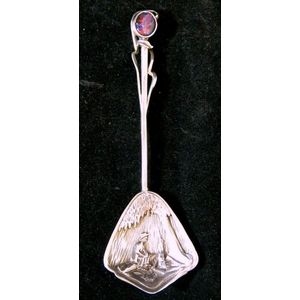19th Century Venus Tear Vial Perfume Bottle & Stand
You must be a subscriber, and be logged in to view price and dealer details.
Subscribe Now to view actual auction price for this item
When you subscribe, you have the option of setting the currency in which to display prices to $Au, $US, $NZ or Stg.
- Manner of .... / Style of ..... - A cataloguing term where the item, in the opinion of the cataloguer is a work in the style of the artist, craftsman or designer, possibly of a later period.
- Aphrodite / Venus - In Greek mythology, Aphrodite is the goddess of love, desire and beauty, whilst in Roman mythology she is called Venus.
- Gilding - Gilding is a method of ornamentation whereby a thin sheet of gold metal is applied to items made of wood, leather, ceramics, glass and silver for decorative purposes.
For furniture including mirrors, the sheet of gold is usually applied over a coating of gesso. Gesso is a mixture of plaster of Paris and gypsum mixed with water and then applied to the carved wooden frames of mirrors and picture frames as a base for applying the gold leaf. After numerous coats of gesso have been applied, allowed to dry and then sanded a coat of "bole", a usually red coloured mixture of clay and glue is brushed on and allowed to dry, after which the gold leaf is applied. Over time parts of the gilding will rub off so the base colour can be seen. In water gilding, this was generally a blue colour, while in oil gilding, the under layer was often yellow. In Victorian times, gilders frequently used red as a pigment beneath the gold leaf.
Metal was often gilded by a process known as fire gilding. Gold mixed with mercury was applied and heated, causing the mercury to evaporate, the long-term effect of which was to kill or disable the craftsman or woman from mercury poisoning. The pursuit of beauty has claimed many victims, not the least of which were the artists who made those pieces so highly sought after today.
This item has been included into following indexes:
Visually similar items

An Zygmunt Libucha Australian sterling silver spoon with opal finial, the shovel shape bowl depicting a swagman by the camp fire., hallmarked ZL Tasmanian devil 925

Four various pieces hallmarked sterling silver tableware, including matching entree & dining fork, London 1851, makers GA (George Adams?); mustard pot, Birmingham 1927, maker HB & S; & mustard spoon, Birmingham 1951. Length 17 & 21 cm (forks). Weight 212g

Pair Georgian hallmarked sterling silver soup spoons. London 1809, maker Eley, Fearn and Chawner; and London 1827, maker CS/WF. Both monogrammed. Weight 122g

Three various sterling silver cream ladles, 1. Edinburgh 1831, 2. Edinburgh, 1838, 3. Sheffield 1952
